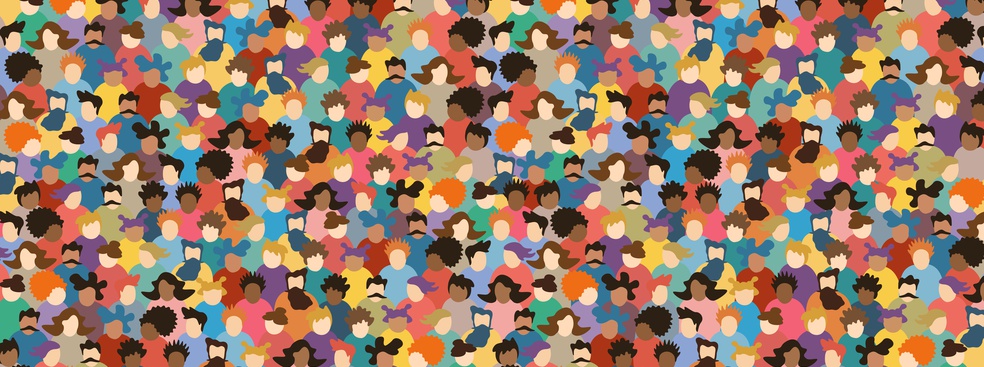With ESSEC Knowledge Editor-in-chief
We want to feel seen, heard, understood – and our relationship to advertising is no different. We want to see ourselves represented, and this includes in the ads we see – and if we see ourselves represented, we’re more likely to feel connected to an ad, making us more likely to make a purchase. This makes diversity in advertising a win-win. Marc Mazodier (ESSEC Business School), Conor M. Henderson (Lundquist College of Business, University of Oregon) and Jamel Khenfer (Zayed University) explored this in recent research (1), finding that minorities who view diverse ads report feeling more connected to the ad and that they are more interested in the advertised product. This means that brands who use diverse, inclusive ads can both contribute to a social cause and see results for their profit margin – an example of doing good while doing well.
We’re increasingly tuned in to the importance of paying attention to diversity and inclusion in policies, in workplace cultures, in hiring, and in business. The United Nations 2030 Sustainable Development Goals has identified the importance of promoting the “social, economic and political inclusion of all irrespective of age, sex, disability, race, ethnicity, origin, religion or economic or other status," (2).
It’s in the vested interest of businesses to do so: a recent report estimated that American purchasing power for non-white consumers has reached $4.9 trillion – close to the combined GDP of France and Italy (3). Despite this, advertising tends to depict primarily white, heterosexual figures until recently (4), meaning advertisers miss out on reaching a substantial segment of the market. This is a pity not only for the consumer, who doesn’t see themselves in the media, but also for the advertiser themselves, due to the relevance of social proof in just how much an ad will sway our behavior. We’ve all heard the saying “When in Rome, do as the Romans do” – this is just one example of how social proof impacts our behavior, since we tend to modify our actions to fit in with the crowd. We tend to buy popular brands and products – we figure that these brands are a reliable choice, and will go over well with those around us. If we’re buying soft drinks for a party, we’ll buy Coke. This is an example of brand leadership.
Inclusiveness in advertising, or integrated advertising, refers to the inclusion of individuals with different social identities and ethnic origins in advertising. People tend to be more likely to use products and support brands that they think represent a group to which they belong (5). Consumers are also more likely to feel linked to society if they see ads that feature people that look like them, and millennials in particular appreciate inclusive advertising (6). If brands use inclusive advertising, they subtly imply that everyone belongs to society, boosting societal identification. Survey results from the US and the UK both suggest that respondents from minority groups felt underrepresented in advertising (7, 8). This advertising homogeneity can also lead people to feel like ads represent how society sees their group(8).
Studying diversity in advertising
The researchers conducted a series of studies to explore diversity and inclusion in advertising.
In the first study, they analyzed a database of over six hundred thousand consumer brand ratings and US census data. They found that those who identified as a minority and lived in racially diverse communities were less likely to want to purchase from mainstream brands.
In the second study, they delved deeper into the psyche of American consumers. They looked at perceptions of advertising inclusiveness – the level to which advertising includes a diverse demographic. When non-white consumers reported lower advertising inclusiveness, it predicted feeling less connected to American society, which itself predicted a decreased intention to purchase from mainstream brands. This effect was stronger among consumers from minority groups.
The third study looked at participants in the United Arab Emirates, comparing reactions to ads showing ethnically diverse models and ads showing ethnically homogenous models, finding a similar pattern to the American sample. When minority consumers saw inclusive ads, they felt more connected to society and more positive about mainstream brands.
This suggests that more inclusive advertising could boost how individuals identify with society, since they would see themselves included in how mainstream media depicts the society in which they live, and that this increased inclusiveness makes people more likely to want to purchase from the brand in question.
Takeaways
With a world in flux, brands need to adapt to the needs of 21st century consumers. One way they can do this is by increasing inclusiveness and including actors from myriad backgrounds in their advertising. This research suggests that minority consumers especially notice a lack of inclusiveness in advertising, and that boosting inclusiveness can also boost their connection to society. Inclusive advertising makes these consumers feel more positively about the brand and more likely to want to purchase from them to reward their diversity and inclusion efforts.
These findings indicate that inclusive, diverse advertising is a solution that can benefit both society and the company, addressing the needs of multiracial societies and emerging social identities. In short, it offers a way for companies to do good (promote societal cohesion) while doing well (increasing consumer loyalty and purchases). A true win-win!
*This project received funding from the CY Initiative of Excellence (grant “Investissements d’Avenir” ANR-16-IDEX-0008) and Zayed University (UAE).
References
-
Henderson, C. M., Mazodier, M., Khenfer, J. (2022). To do well by doing good: Improving country identification and advertising performance through multiethnic advertising. Working paper.
-
United Nations (2022). Goal 10: Reduce inequality within and among countries. United Nations. https://www.un.org/sustainabledevelopment/inequality/
-
Melancon, M. (2021). Consumer buying power is more diverse than ever. UGA Today. https://news.uga.edu/selig-multicultural-economy-report-2021/.
-
Poole, D., Page, G., & Sidlova, V. (2021). Beyond brand activism: 3 routes to inclusive advertising. Kantar. https://www.kantar.com/inspiration/advertising-media/beyond-brand-activism-three-routes-to-inclusive-advertising
-
Park, Y. W., Voss, G. B., & Voss, G. V. (2022). Advancing customer diversity, equity, inclusion: Measurement, stakeholder influence, and the role of marketing. Journal of the Academy of Marketing Science, https://doi.org/10.1007/s11747-022-00883-6.
-
Licsandru, T. C., & Cui, C. C. (2019). Ethnic marketing to the global millennial consumers: Challenges and opportunities. Journal of Business Research, 103, 261-274.
-
Chiu, B. (2019). Addressing The Ad Industry's Sticky Problem With Race. Forbes. https://www.forbes.com/sites/bonniechiu/2019/07/16/addressing-the-ad-industrys-sticky-problem-with-race/
-
Jefferson, M. (2022). Quarter of BAME consumers see 'no improvement' in advertising's portrayal of diverse groups. Marketing Week. https://www.marketingweek.com/portrayal-diverse-ads-not-improved/









